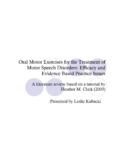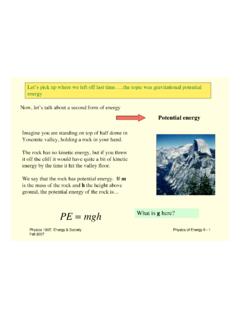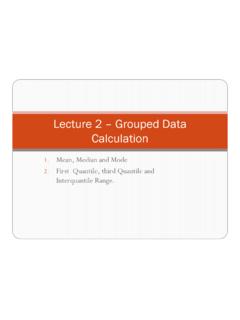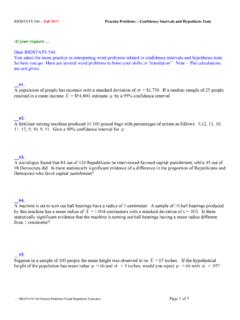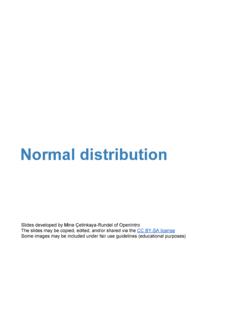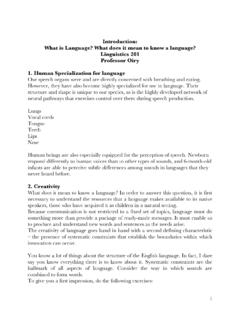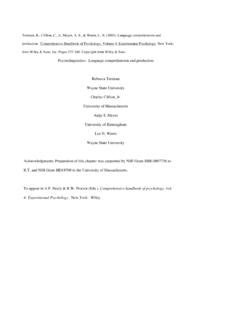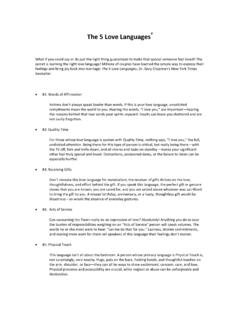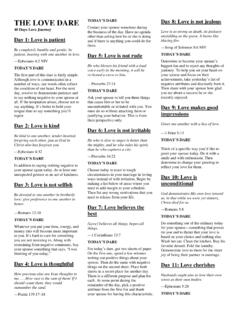Transcription of I. Practice in 1st-order predicate logic – with answers.
1 More Answers for Practice in logic and HW Ling 310 Feb 27, 2006 1 More Answers for Practice in logic and HW 1 This is an expanded version showing additional right and wrong answers. I. Practice in 1st-order predicate logic with answers. 1. Mary loves everyone. [assuming D contains only humans] x love (Mary, x) Note: No further parentheses are needed here, and according to the syntax on the handout, no further parentheses are possible. But extra parentheses are in general considered acceptable, and if you find them helpful, I have no objection. So I would also count as correct any of the following: x ( love (Mary, x)), ( x love (Mary, x)), ( x ( love (Mary, x))) 2.
2 Mary loves everyone. [assuming D contains both humans and non-humans, so we need to be explicit about everyone as every person ] x (person(x) love (Mary, x)) A wrong answer: x (person(x) & love (Mary, x)) This says that everything in the universe is a person and loves Mary. 3. No one talks. [assume D contains only humans unless specified otherwise.] x talk(x) or equivalently, x talk(x) 4. Everyone loves himself. x love (x, x) 5. Everyone loves everyone. x y love (x, y) 6. Everyone loves everyone except himself. (= Everyone loves everyone else.) x y( x = y love (x, y)) or x y( x y love (x, y)) Or maybe it should be this, which is not equivalent to the pair above: x y( x = y love (x, y)) or x y( x y love (x, y)) The first pair allows an individual to also love himself; the second pair doesn t.
3 7. Every student smiles. x (student(x) smile( x)) 8. Every student except George smiles. x ((student(x) & x George) smile( x)) That formula allows the possibility that George smiles too; if we want to exclude it (this depends on what you believe about except; there are subtle differences and perhaps some indeterminacy among except, besides, other than and their nearest equivalents in other languages), then it should be the following, or something equivalent to it: x ((student(x) (x George smile( x))) 9. Everyone walks or talks. x (walk (x) talk (x)) 10. Every student walks or talks. More Answers for Practice in logic and HW Ling 310 Feb 27, 2006 2 x (student(x) (walk (x) talk (x))) 11.)
4 Every student who walks talks. x ((student(x) & walk (x)) talk (x))) or x (student(x) (walk (x) talk (x))) 12. Every student who loves Mary is happy. x ((student(x) & love (x, Mary)) happy (x))) 13. Every boy who loves Mary hates every boy who Mary loves. x((boy(x) & love (x, Mary)) y((boy(y) & love (Mary, y)) hate (x,y))) 14. Every boy who loves Mary hates every other boy who Mary loves. (So if John loves Mary and Mary loves John, sentence 13 requires that John hates himself, but sentence 14 doesn t require that.) x((boy(x) & love (x, Mary)) y((boy(y) & love (Mary, y) & y x) hate (x,y))) II. Homework #1, with answers.
5 1. Everyone loves Mary. x love (x, Mary) 2. John does not love anyone. (Not ambiguous, but there are two equivalent and equally good formulas for it, one involving negation and the existential quantifier, the other involving negation and the universal quantifier. Give both.) x love (John, x) or equivalently, x love (John, x) Wrong: x love (John, x) :That says there is someone John doesn t love . Wrong: x love (John, x): That says John doesn t love everyone; it s equivalent to the preceding formula. 3. Everyone who sees Mary loves Mary. x (see (x, Mary) love (x, Mary)) 4. Everyone loves someone. (Ambiguous) (i) x y love (x, y) (For every person x, there is someone whom x loves.)
6 (ii) y x love (x, y) (There is some person y whom everyone loves, everyone loves some one specific person.) 5. Someone loves everyone. (Ambiguous) (i) x y love (x, y) (There is some person x who loves everyone.) (ii) y x love (x, y) (For every person y, there is someone who loves them , no one is totally unloved. This second reading is probably dispreferred for the active sentence. It s the preferred reading for the passive sentence Everyone is loved by someone and it s the only reading for the agentless passive Everyone is loved. ) 6. Someone walks and talks. More Answers for Practice in logic and HW Ling 310 Feb 27, 2006 3 x(walk (x) & talk (x)) 7.
7 Someone walks and someone talks. ( x walk (x) & x talk (x)) or ( x walk (x) & y talk (y)) Because neither quantifier is inside the scope of the other their scopes are independent it doesn t matter whether we use different variables here or use the same variable twice. But if one quantifier is inside the scope of the other, then it matters a great deal. When one quantifier is inside the scope of another, as in questions 4 and 5 above, always give them different variables! Also equivalent: x y(walk (x) & talk (y)) 8. Everyone who walks is calm. x (walk(x) calm( x)) 9. No one who runs walks. (Not ambiguous, but same note as for number 2.)
8 (i) x (run (x) & walk (x)) or equivalently, (ii) x (run(x) walk(x)) or equivalently, (iii) x (run (x) & walk (x)) A wrong answer: x ( run(x) walk(x)) What does this one say? Another wrong answer: x (run (x) walk (x)) This one doesn t correspond to any English sentence; see notes to questions 11 and 6 below. 10. Everyone who Mary loves loves someone who is happy. x( love (Mary, x) y( love (x,y) & happy( y))) Also correct: x y ( love (Mary, x) ( love (x,y) & happy( y))) But I recommend keeping each quantifier as close as possible to the noun it quantifies, or to its surface position.
9 The more you move quantifiers around, the easier it is to make mistakes. 11. If anyone cheats, he suffers. (English paraphrases: Anyone who cheats suffers. Everyone who cheats suffers. On the subtle difference between these two, see (Kadmon and Landman 1993).) x (cheat(x) suffer( x)) A wrong answer: x(cheat(x) suffer( x)) A wide scope x like this creates too weak a statement. If x were given scope only over the antecedent, as in: xcheat(x) suffer( x), then that error would be corrected but there would be a new problem because the second x would not be bound. Note on any: Sometimes anyone corresponds to and sometimes to ; you have to think about the meaning of the whole sentence.
10 Many papers have been written exploring the issue of how best to account for the distribution of meanings of any, and whether it does or doesn t require lexical ambiguity as part of the account. A few classics include (Carlson 1980, Carlson 1981, Haspelmath 1997, Hintikka 1980, Kadmon and Landman 1993, Kratzer and Shimoyama 2002, Ladusaw 1980, Linebarger 1987, Vendler 1962). See also the note about any in the next item. More Answers for Practice in logic and HW Ling 310 Feb 27, 2006 4 12. If anyone cheats, everyone suffers. x (cheat(x) y suffer(y)) Equivalent: x y (cheat(x) suffer(y)) Also equivalent: y x (cheat(x) suffer(y)) Also equivalent: x cheat(x) y suffer( y) (Each quantifier has narrow scope here.)
